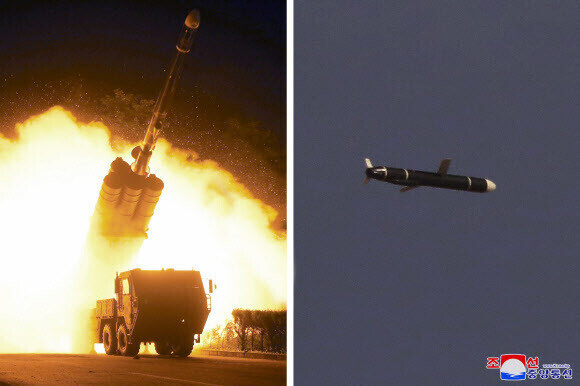hankyoreh
Links to other country sites 다른 나라 사이트 링크
Seoul, Pyongyang make conflicting claims about cruise missile test near Ulsan

On Monday, the North Korean military claimed it had launched two cruise missiles into the waters off the South Korean city of Ulsan on Nov. 2 while summarizing daily military operations on Nov. 2–5 in response to South Korea and the US’ “Vigilant Storm” joint exercises (Oct. 3–-Nov. 5).
But South Korea’s Joint Chiefs of Staff responded that “the North Korean claim is not factual.”
A report by the General Staff of the Korean People’s Army (KPA) that was published on Monday by North Korea’s state-run Korean Central News Agency (KCNA) described Vigilant Storm as “the largest-ever” joint exercise by South Korea and as “a dangerous war drill of [a] very high aggressive nature.”
The KPA General Staff said it had “conducted [. . .] corresponding military operations” to demonstrate “the clear self-confidence in the military capabilities of the armed forces of DPRK [North Korea] and to inspire [. . .] the conviction of sure victory.”
Regarding the status of its operations on Nov. 2, the KPA said, “Claiming that a [North Korean] missile dropped near the ‘territorial waters’ of South Korea that afternoon, the enemy fired in return air-to-surface guided missiles and gliding guided [bombs] at the open sea of the DPRK side. Corresponding to this rash act, the KPA fired two strategic cruise missiles with [a] shooting range of 590.5 km at the open sea around 80 km off the coast of Ulsan City of South Korea [. . .] from North Hamgyong Province.”
This claim by the North Korean military clashes with the explanation provided by South Korea’s Joint Chiefs of Staff on Nov. 2.
The Joint Chiefs said at the time that a North Korean ballistic missile had crossed the Northern Limit Line (NLL) in the East Sea and flown for 26 km, falling into the open sea 57 km to the east of Sokcho, Gangwon Province. But the Joint Chiefs’ announcement didn’t contain any information about North Korea firing “strategic cruise missiles [. . .] off the coast of Ulsan,” as Pyongyang claimed.
“The conclusion of detection and analysis by South Korean and American surveillance and reconnaissance assets is that the North Korean claim is not factual. So far, nothing has been picked up or detected,” said Kim Jun-rak, head of public relations for the Joint Chiefs.
It’s possible that North Korea’s cruise missiles were missed by the radar that South Korean and American intelligence agencies operate to detect ballistic missiles. It’s also possible that North Korea is attempting to sow confusion by claiming to have launched cruise missiles when it actually did not.
The Joint Chiefs’ means of detecting and tracking North Korean missiles are Green Pine radars deployed in Chungcheong Province and Busan and Aegis radars installed on naval vessels. Since these radars are focused on the trajectories of ballistic missiles — which rise to an altitude of dozens of kilometers before falling in a parabolic arc — they reportedly are limited in their ability to detect cruise missiles, which fly at a low altitude of no more than a few kilometers.
When North Korea announced that it had successfully test-launched a cruise missile with a maximum range of 1,500 km on Sept. 13, 2021, the South Korean and American intelligence authorities reportedly failed to detect or track the missile.
In a related development, South Korean military analysts said that an intercontinental ballistic missile (ICBM) test-launched by North Korea on Nov. 3 failed to achieve normal flight, but North Korea didn’t mention that launch in the KPA report on Monday.
By Kwon Hyuk-chul, staff reporter
Please direct questions or comments to [english@hani.co.kr]

Editorial・opinion
![[Column] Has Korea, too, crossed the Rubicon on China? [Column] Has Korea, too, crossed the Rubicon on China?](https://flexible.img.hani.co.kr/flexible/normal/500/300/imgdb/original/2024/0419/9317135153409185.jpg) [Column] Has Korea, too, crossed the Rubicon on China?
[Column] Has Korea, too, crossed the Rubicon on China?![[Correspondent’s column] In Japan’s alliance with US, echoes of its past alliances with UK [Correspondent’s column] In Japan’s alliance with US, echoes of its past alliances with UK](https://flexible.img.hani.co.kr/flexible/normal/500/300/imgdb/original/2024/0419/2317135166563519.jpg) [Correspondent’s column] In Japan’s alliance with US, echoes of its past alliances with UK
[Correspondent’s column] In Japan’s alliance with US, echoes of its past alliances with UK- [Editorial] Does Yoon think the Korean public is wrong?
- [Editorial] As it bolsters its alliance with US, Japan must be accountable for past
- [Guest essay] Amending the Constitution is Yoon’s key to leaving office in public’s good graces
- [Editorial] 10 years on, lessons of Sewol tragedy must never be forgotten
- [Column] A death blow to Korea’s prosecutor politics
- [Correspondent’s column] The US and the end of Japanese pacifism
- [Guest essay] How Korea turned its trainee doctors into monsters
- [Guest essay] As someone who helped forge Seoul-Moscow ties, their status today troubles me
Most viewed articles
- 1[Column] The clock is ticking for Korea’s first lady
- 2Hong Se-hwa, voice for tolerance whose memoir of exile touched a chord, dies at 76
- 3After 2 months of delayed, denied medical care, Koreans worry worst may be yet to come
- 4[Column] Has Korea, too, crossed the Rubicon on China?
- 5[Correspondent’s column] In Japan’s alliance with US, echoes of its past alliances with UK
- 6US overtakes China as Korea’s top export market, prompting trade sanction jitters
- 7Samsung barricades office as unionized workers strike for better conditions
- 8All eyes on Xiaomi after it pulls off EV that Apple couldn’t
- 9More South Koreans, particularly the young, are leaving their religions
- 10John Linton, descendant of US missionaries and naturalized Korean citizen, to lead PPP’s reform effo